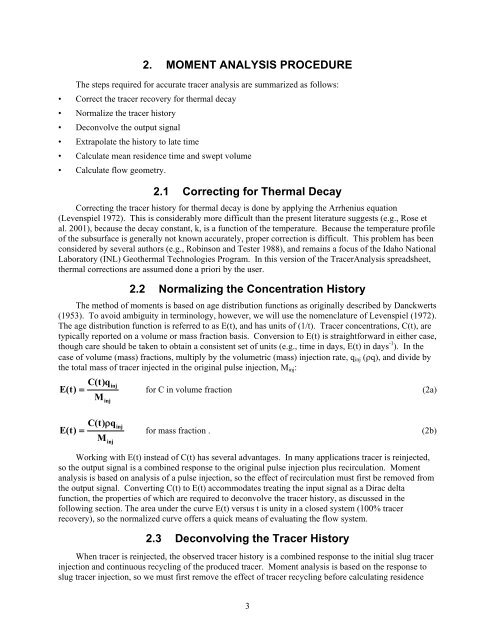Tracer Interpretation Using Temporal Moments on a Spreadsheet G
Tracer Interpretation Using Temporal Moments on a Spreadsheet G
Tracer Interpretation Using Temporal Moments on a Spreadsheet G
You also want an ePaper? Increase the reach of your titles
YUMPU automatically turns print PDFs into web optimized ePapers that Google loves.
2. MOMENT ANALYSIS PROCEDURE<br />
The steps required for accurate tracer analysis are summarized as follows:<br />
• Correct the tracer recovery for thermal decay<br />
• Normalize the tracer history<br />
• Dec<strong>on</strong>volve the output signal<br />
• Extrapolate the history to late time<br />
• Calculate mean residence time and swept volume<br />
• Calculate flow geometry.<br />
2.1 Correcting for Thermal Decay<br />
Correcting the tracer history for thermal decay is d<strong>on</strong>e by applying the Arrhenius equati<strong>on</strong><br />
(Levenspiel 1972). This is c<strong>on</strong>siderably more difficult than the present literature suggests (e.g., Rose et<br />
al. 2001), because the decay c<strong>on</strong>stant, k, is a functi<strong>on</strong> of the temperature. Because the temperature profile<br />
of the subsurface is generally not known accurately, proper correcti<strong>on</strong> is difficult. This problem has been<br />
c<strong>on</strong>sidered by several authors (e.g., Robins<strong>on</strong> and Tester 1988), and remains a focus of the Idaho Nati<strong>on</strong>al<br />
Laboratory (INL) Geothermal Technologies Program. In this versi<strong>on</strong> of the <str<strong>on</strong>g>Tracer</str<strong>on</strong>g>Analysis spreadsheet,<br />
thermal correcti<strong>on</strong>s are assumed d<strong>on</strong>e a priori by the user.<br />
2.2 Normalizing the C<strong>on</strong>centrati<strong>on</strong> History<br />
The method of moments is based <strong>on</strong> age distributi<strong>on</strong> functi<strong>on</strong>s as originally described by Danckwerts<br />
(1953). To avoid ambiguity in terminology, however, we will use the nomenclature of Levenspiel (1972).<br />
The age distributi<strong>on</strong> functi<strong>on</strong> is referred to as E(t), and has units of (1/t). <str<strong>on</strong>g>Tracer</str<strong>on</strong>g> c<strong>on</strong>centrati<strong>on</strong>s, C(t), are<br />
typically reported <strong>on</strong> a volume or mass fracti<strong>on</strong> basis. C<strong>on</strong>versi<strong>on</strong> to E(t) is straightforward in either case,<br />
though care should be taken to obtain a c<strong>on</strong>sistent set of units (e.g., time in days, E(t) in days -1 ). In the<br />
case of volume (mass) fracti<strong>on</strong>s, multiply by the volumetric (mass) injecti<strong>on</strong> rate, q inj (q), and divide by<br />
the total mass of tracer injected in the original pulse injecti<strong>on</strong>, M inj :<br />
C(t)q<br />
inj<br />
E(t)<br />
for C in volume fracti<strong>on</strong> (2a)<br />
M<br />
inj<br />
C(t) qinj<br />
E(t) for mass fracti<strong>on</strong> . (2b)<br />
M<br />
inj<br />
Working with E(t) instead of C(t) has several advantages. In many applicati<strong>on</strong>s tracer is reinjected,<br />
so the output signal is a combined resp<strong>on</strong>se to the original pulse injecti<strong>on</strong> plus recirculati<strong>on</strong>. Moment<br />
analysis is based <strong>on</strong> analysis of a pulse injecti<strong>on</strong>, so the effect of recirculati<strong>on</strong> must first be removed from<br />
the output signal. C<strong>on</strong>verting C(t) to E(t) accommodates treating the input signal as a Dirac delta<br />
functi<strong>on</strong>, the properties of which are required to dec<strong>on</strong>volve the tracer history, as discussed in the<br />
following secti<strong>on</strong>. The area under the curve E(t) versus t is unity in a closed system (100% tracer<br />
recovery), so the normalized curve offers a quick means of evaluating the flow system.<br />
2.3 Dec<strong>on</strong>volving the <str<strong>on</strong>g>Tracer</str<strong>on</strong>g> History<br />
When tracer is reinjected, the observed tracer history is a combined resp<strong>on</strong>se to the initial slug tracer<br />
injecti<strong>on</strong> and c<strong>on</strong>tinuous recycling of the produced tracer. Moment analysis is based <strong>on</strong> the resp<strong>on</strong>se to<br />
slug tracer injecti<strong>on</strong>, so we must first remove the effect of tracer recycling before calculating residence<br />
3
















